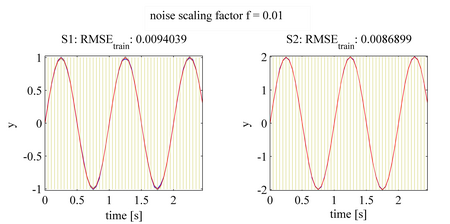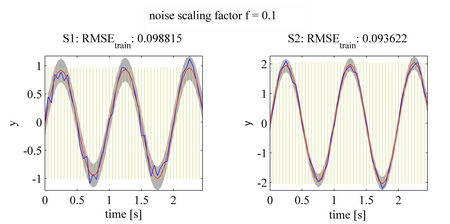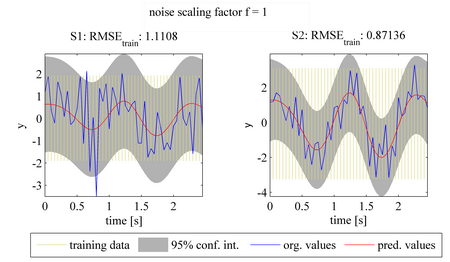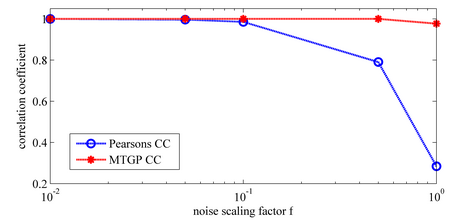Demo 5: Noise Free Correlation Analysis
File name: correlation/demoMTGP_noisefree_correlation.m
Based on the correlation results of demo 4, more complex correlation analysis can be performed. This demo illustrates how MTGPs may be used to analyse the correlation between two tasks independently of the measurement noise. To use demoMTGP_noisefree_correlation.m, please include the path of the GPML toolbox or specify the path in demoMTGP_noisefree_correlation.m (line 15).
We assume the scenario that two tasks (S1 and S2) are given which were acquired with the same measurement equipment (e.g., two EEG channels measured with the same signal amplifier). The aim is to compute the correlation between these two tasks independently of the noise of the measurement equipment. To simulate this, we assume two sinusoidal signals are given (as shown in the upper plot, above), which are perfectly correlated. We add Gaussian noise N(0,f) to both tasks, where f = [0.01, 0.05, 0.1, 0.5, 1]. The first row of the above shows the original dataset (blue solid line) with f = 0.01; the second row of the above shows the data with f = 0.1, and the third row shows the data with f = 1. For each case, a MTGP model can be trained. The predictions are shown by the red solid lines and the confidence intervals by the grey shaded areas. As the noise on the signals is increased, the confidence intervals on the predictions increases as anticipated. However, it may be seen that the mean prediction results still describe the sinusoidal behaviour of both tasks.
This above plot shows the normalised MTGP correlation coefficient and the Pearson's correlation coefficient between tasks S1 and S2 depending on the noise scaling factor f. It may be observed that with increasing f, the value of Pearson's correlation coefficient decreases due to the increasing noise. In contrast, the normalised MTGP correlation coefficients remains high and seems to be less dependent on the noise factor f, demonstrating increased robustness of the MTGP's estimate of the correlation between tasks.

- Forschung
- SonoBox: Ein Roboter-Ultraschallsystem zur Diagnose von Unterarmfrakturen bei Kindern
- Robotics Laboratory (RobLab)
- OLRIM
- MIRANA
- Robotik auf der digitalen Weide
- KRIBL
- Ultraschallgeführte Strahlenchirurgie
- Digitaler Superzwilling: Projekt TWIN-WIN
- - Abgeschlossene Projekte -
- Hochpräzise Bewegungsverfolgung am Kopf in der Strahlentherapie
- Neurologische Modellierungen
- Modellierung von Herzbewegungen
- Bewegungskompensation in der Strahlentherapie
- Navigation and Visualisation in Endovascular Aortic Repair (Nav EVAR)
- Autonome Elektrofahrzeuge als urbane Lieferanten
- Ziel-basierendes lebenslanges autonomes Lernen
- Transkranielle Elektrostimulation
- Bestrahlungsplanung
- Transkranielle Magnetstimulation
- Navigation in der Leberchirurgie
- Stereotaktische Mikronavigation
- OP - Mikroskop
- Interaktiver C-Arm
- OCT-basierte Neurobildgebung




